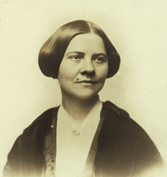


 |
Issue Contents :: Feature :: Lucy Stone: Lost and Found :: Page [ 1 2 3 ]
"It's wonderful her homesite is being preserved," says Joelle Million, noted Lucy Stone biographer, author of Woman's Voice, Woman's Place: Lucy Stone and the Birth of the Woman's Rights Movement. "In a country that commemorates just about everything, there's nothing for Lucy. There's not even a gravesite because she was cremated. And, ironically, her ashes are stored in an urn labeled Blackwell–her husband's name. After a lifetime of not giving up her own name, in death, she lost it."
Million, a midwesterner by birth who now lives not far from Lucy's childhood home, is helping the Trustees collect written documents that illuminate Lucy's lifelong connection to Coy's Hill. "From her letters, we know she loved the nature, the rocks, the brooks, the fields. She scampered the land, climbed trees, and led the cows to pasture." When Lucy began traveling the country as a professional speaker for the Anti-Slavery Society, she often returned to the farm between engagements. Of a visit home she once wrote, "It reminds me of those early days, when I seemed to hold converse with the winds and find companions in the clouds." Later, when Henry Blackwell was doggedly pursuing her hand in marriage, she fled to Coy's Hill. Eventually she married him, right there at the farm. And when she and Blackwell were living in Cincinnati, she took annual vacations back to the farm with her daughter, Alice. "Coy's Hill was a touchstone for her," says Wyman.
 |
Lucy Stone / Photo Courtesy Oberlin Archives |
"More work needs to be done on her," says Million. The whole of women's history was ignored until the latter part of the 20th century and even then, Elizabeth Cady Stanton and Susan B. Anthony are the names that leap out in bold typeface on the page. Because of a rift in the movement, Lucy's legacy gathered dust.
Lucy was one of the first and most outspoken advocates for women's rights and abolition in the mid-1800s. Her radicalism on both subjects brought large crowds, often numbering in the thousands, but some of the listeners were hostile. Reports tell of people tearing down posters advertising her speeches, of burning pepper in the places she spoke, and of pelting her with prayer books.
After the Civil War and the abolition of slavery, black men gained the right to vote while women did not. But when Lucy Stone refused to join her peers, including Stanton and Anthony, in isolating the right for women's suffrage from that of black men, she created a divide that nearly wrote her out of history–quite literally.
The ideological differences that developed between Lucy Stone and Stanton resulted in the organization of two separate groups. The National Woman Suffrage Association founded by Stanton and Anthony was largely made up of New York residents. Lucy Stone's American Woman Suffrage Association was much wider reaching in its membership.
The two factions merged decades later, but in the interim, Stanton and Anthony had edited the book History
of Woman Suffrage, which became the most widely recognized tome on the subject. Not coincidentally it glossed over Lucy's giant role in the fight for women's suffrage and human rights.
While scholars continue to research and debate the finer points of suffrage history, one fact is indisputable. Lucy Stone had a mesmerizing voice. "It was variously described as the perfect instrument, magical, silvery," says Million. "Many reviewers of the day commented on Lucy's frank demeanor, her empathy with audience, and on the power of her voice to convert listeners. Stone was a gifted speaker in the Golden Age of Oratory, an era when people attended lectures for information and entertainment. It's how ideas were spread."
In the woodsy silence of Lucy's childhood home, it is surprisingly easy to imagine her silvery voice calling out clear and true.
"The primary mission of the site will be to teach," says Wyman, as we make our way back into the September sunshine. "It's an opportunity for visitors to learn about Lucy Stone at the place where she was born and where her ideas about women's rights first took form, to walk where she walked, to sit and reflect." Eventually, the Trustees hope to hire a historical portrayer to bring Lucy's voice to life for visitors.
Buying the Coy's Hill property was the first hurdle. Now sights are set on raising $140,000 to pay for planning, site improvements, and ongoing management. Though Wyman has changed jobs, he is not letting Lucy go. He remains a member of the volunteer committee helping to direct development of the site. The group has already decided the home will not be rebuilt, partly because of cost, but also because part of the story is the evolution of the landscape. Funds will pay for building trails and a parking lot, clearing brush (and poison ivy), and creating interpretive signs and panels to tell visitors Lucy's story.
"Lucy is an inspiration. She spent her entire life trying to change people's minds, people who had very fixed opinions," says Wyman. "She and her ideas were born here. What was it about this time and place that unleashed this in her? She had a strong moral compass and the courage and perseverance to follow it."